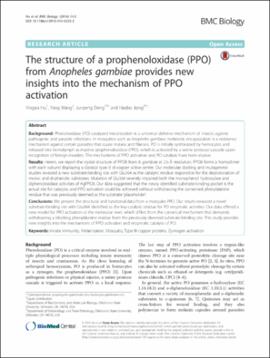| dc.contributor.author | Hu, Yingxia | |
| dc.contributor.author | Wang, Yang | |
| dc.contributor.author | Deng, Junpeng | |
| dc.contributor.author | Jiang, Haobo | |
| dc.date.accessioned | 2018-11-09T21:10:44Z | |
| dc.date.available | 2018-11-09T21:10:44Z | |
| dc.date.issued | 2016-01-05 | |
| dc.identifier | oksd_hu_thestructureofa_2016 | |
| dc.identifier.citation | Hu, Y., Wang, Y., Deng, J., & Jiang, H. (2016). The structure of a prophenoloxidase (PPO) from Anopheles gambiae provides new insights into the mechanism of PPO activation. BMC Biology, 14, Article 2. https://doi.org/10.1186/s12915-015-0225-2 | |
| dc.identifier.uri | https://hdl.handle.net/11244/302048 | |
| dc.description.abstract | Background: Phenoloxidase (PO)-catalyzed melanization is a universal defense mechanism of insects against pathogenic and parasitic infections. In mosquitos such as Anopheles gambiae, melanotic encapsulation is a resistance mechanism against certain parasites that cause malaria and filariasis. PO is initially synthesized by hemocytes and released into hemolymph as inactive prophenoloxidase (PPO), which is activated by a serine protease cascade upon recognition of foreign invaders. The mechanisms of PPO activation and PO catalysis have been elusive. | |
| dc.description.abstract | Results: Herein, we report the crystal structure of PPO8 from A. gambiae at 2.6 A resolution. PPO8 forms a homodimer with each subunit displaying a classical type III di-copper active center. Our molecular docking and mutagenesis studies revealed a new substrate-binding site with Glu364 as the catalytic residue responsible for the deprotonation of mono- and di-phenolic substrates. Mutation of Glu364 severely impaired both the monophenol hydroxylase and diphenoloxidase activities of AgPPO8. Our data suggested that the newly identified substrate-binding pocket is the actual site for catalysis, and PPO activation could be achieved without withdrawing the conserved phenylalanine residue that was previously deemed as the substrate 'placeholder'. | |
| dc.description.abstract | Conclusions: We present the structural and functional data from a mosquito PPO. Our results revealed a novel substrate-binding site with Glu364 identified as the key catalytic residue for PO enzymatic activities. Our data offered a new model for PPO activation at the molecular level, which differs from the canonical mechanism that demands withdrawing a blocking phenylalanine residue from the previously deemed substrate-binding site. This study provides new insights into the mechanisms of PPO activation and enzymatic catalysis of PO. | |
| dc.format | application/pdf | |
| dc.language | en_US | |
| dc.publisher | BioMed Central | |
| dc.rights | This material has been previously published. In the Oklahoma State University Library's institutional repository this version is made available through the open access principles and the terms of agreement/consent between the author(s) and the publisher. The permission policy on the use, reproduction or distribution of the material falls under fair use for educational, scholarship, and research purposes. Contact Digital Resources and Discovery Services at lib-dls@okstate.edu or 405-744-9161 for further information. | |
| dc.title | Structure of a prophenoloxidase (PPO) from Anopheles gambiae provides new insights into the mechanism of PPO activation | |
| osu.filename | oksd_hu_thestructureofa_2016.pdf | |
| dc.description.peerreview | Peer reviewed | |
| dc.identifier.doi | 10.1186/s12915-015-0225-2 | |
| dc.description.department | Biochemistry and Molecular Biology | |
| dc.description.department | Entomology and Plant Pathology | |
| dc.type.genre | Article | |
| dc.type.material | Text | |
| dc.subject.keywords | innate immunity | |
| dc.subject.keywords | melanization | |
| dc.subject.keywords | mosquito | |
| dc.subject.keywords | type III copper proteins | |
| dc.subject.keywords | zymogen activation | |
